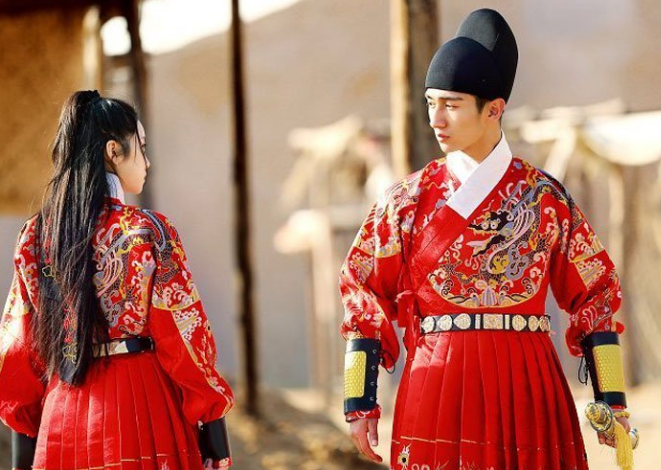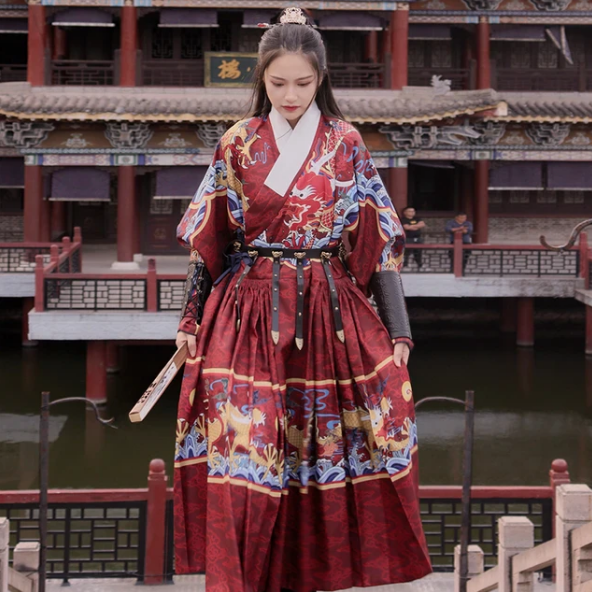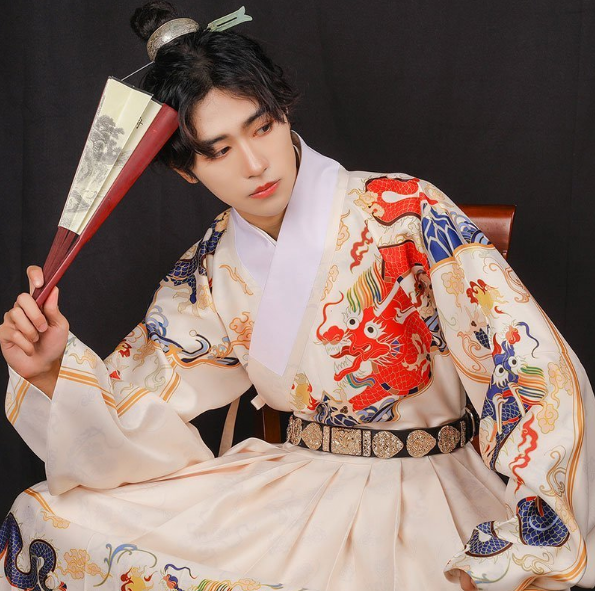Origins and Early Development of the Flying Fish Suit
The Flying Fish Suit, an emblematic garment of the Ming Dynasty, emerged as a distinctive symbol of status and power. Crafted meticulously, these suits were more than mere clothing; they were a testament to the wearer’s position and influence within the intricate social hierarchy of the era.
Background: Political and Cultural Context of Early Ming Dynasty
In the early Ming Dynasty, political stability and cultural flourishing set the stage for distinct advancements in fashion. This period, marked by renewed emphasis on traditional values and a strong central government, saw the birth of the Flying Fish Suit. It was a time when clothing was not just a necessity but a statement of identity and allegiance. The emergence of this unique attire coincided with a heightened sense of national pride and cultural renaissance.

Initial Intent: Original Style and Symbolic Meaning of the Flying Fish Suit
The original style of the Flying Fish Suit was both functional and symbolic. Designed to convey authority, the suit featured intricate patterns and quality materials, reflecting the wealth and status of the wearer. Each element of the suit, from the fabric to the embroidery, was imbued with symbolic meaning, often related to traditional Chinese beliefs and values. The suit’s distinctive appearance was not only a reflection of the wearer’s rank but also a nod to the cultural and philosophical ethos of the Ming Dynasty.
In crafting these suits, artisans paid meticulous attention to detail, ensuring that every aspect of the garment was perfect. The combination of artistic craftsmanship and cultural significance made the Flying Fish Suit a notable example of Ming Dynasty sartorial elegance.
For more detailed information on the political and cultural context of the Ming Dynasty, as well as the symbolic meanings associated with traditional Chinese garments, you can refer to the Ming Dynasty and Chinese Clothing pages on Wikipedia.
Design Details and Craftsmanship of the Flying Fish Suit
The Flying Fish Suit, a masterpiece of Ming Dynasty fashion, showcases exquisite design and unparalleled craftsmanship. Each suit was a work of art, reflecting the era’s aesthetic values and the artisan’s skill.
Material Selection: Significance of Fabrics and Colors
Selecting materials for the Flying Fish Suit was a process steeped in symbolism and quality. Silk, valued for its luxurious texture and sheen, was the primary fabric, often in vibrant colors like red or blue, symbolizing prosperity and nobility. Gold threads were sometimes woven into the fabric for added opulence, representing wealth and high status. The color choices were not random but carefully selected to align with the cultural and philosophical beliefs of the time.
Craftsmanship: Demonstration of Ancient Garment Making Techniques
Crafting a Flying Fish Suit required unparalleled skill and years of training. Artisans used ancient techniques, meticulously hand-sewing each piece and embroidering intricate patterns that often had mythological or natural themes, like dragons or waves. This level of detail demanded a high degree of precision, making each suit a unique testament to the craftsman’s expertise.
The Flying Fish Suit’s design and creation process involved not just technical skills but also a deep understanding of Ming Dynasty culture and aesthetics. These garments were not merely worn but celebrated as icons of cultural identity and artistic achievement.
For more insights into the materials and techniques used in historical Chinese garments, you might find the Chinese Textiles and Embroidery of China Wikipedia pages particularly enlightening.
Role of the Flying Fish Suit in Social Hierarchy
The Flying Fish Suit played a pivotal role in the social hierarchy of the Ming Dynasty, serving as a clear indicator of one’s status and rank within the intricate layers of society.
Social Status: Use of the Suit Across Different Classes
The Flying Fish Suit was primarily the privilege of the elite, particularly those in governmental or high-ranking positions. Its use among different classes was strictly regulated, with variations in design and embellishment indicating the wearer’s precise rank and position. Higher officials donned suits with more elaborate designs and finer materials, while lower ranks had more modest versions. This strict demarcation by clothing reinforced social stratification, making the Flying Fish Suit a key element in the visual representation of the Ming Dynasty’s social order.
Symbol of Power: How the Garment Reflects Political Standing
In the Ming Dynasty, clothing was a powerful symbol of political standing. The Flying Fish Suit, in particular, was more than just attire; it was a statement of authority and influence. The intricacy of its design, the quality of the fabric, and the colors used were all meticulously chosen to reflect the wearer’s power and position. Wearing such a suit was a privilege reserved for those in positions of power, and it visibly communicated their status to others. It was a symbol of prestige and respect, embodying the political and social hierarchy of the time.
The Flying Fish Suit’s role in the social and political landscape of the Ming Dynasty underscores the importance of clothing as a marker of status and power. For a deeper understanding of social stratification and symbols of power in historical contexts, the Wikipedia pages on Social Class in the Ming Dynasty and Symbols of Power provide valuable insights.
Functionality and Practicality of the Flying Fish Suit
The Flying Fish Suit was not only a symbol of status but also a functional garment, tailored to meet the demands of official duties and ceremonial events in the Ming Dynasty.
Official Use: Variations in Usage for Daily Life and Ceremonies
For daily official duties, the Flying Fish Suit was designed to be practical yet dignified. It allowed for ease of movement while maintaining an air of authority. During ceremonial occasions, the suits were more elaborate, featuring intricate embroidery and additional adornments. These variations ensured that the suit was both appropriate and functional for the wide range of activities that officials of the Ming Dynasty engaged in.
Adjustments and Modifications: Design Changes for Different Occasions
Depending on the occasion, the Flying Fish Suit underwent various adjustments and modifications.People preferred lighter materials and simpler designs for everyday use, with a focus on comfort and practicality.During high-profile events and ceremonies, they used heavier fabrics, brighter colors, and more elaborate decorations to convey a sense of grandeur and formality.These modifications represented not only aesthetic choices but also practical adaptations to the diverse settings in which people wore the suit.
The design and adaptability of the Flying Fish Suit highlight its practical aspects, ensuring it met the needs of the wearer in both official and ceremonial contexts. For more information on historical clothing functionality, the Wikipedia page on Historical Clothing provides a broader perspective.

Impact of the Flying Fish Suit in Ming Dynasty Culture
The Flying Fish Suit, beyond its practical use, had a profound impact on Ming Dynasty culture, influencing various aspects of art, literature, and fashion.
Cultural Symbolism: Representation of the Suit in Literature and Art
In Ming Dynasty literature and art, the Flying Fish Suit often symbolized authority and prestige. Writers and artists frequently depicted officials in these suits, using them as visual shorthand for power and status. The suit’s representation in paintings, especially, served to immortalize the cultural significance and aesthetic appeal of this garment. It became a symbol not only of the person wearing it but of the era’s broader cultural and political ethos.
Social Influence: Impact on Contemporary Fashion Trends of the Time
The Flying Fish Suit significantly influenced contemporary fashion trends of the Ming Dynasty. Its design elements, such as the use of silk and intricate embroidery, became popular among the upper classes, even in clothing that was not part of official attire. The suit’s popularity led to a broader appreciation of finely made garments and set a high standard for craftsmanship and luxury in clothing. This influence extended beyond the court and into the wider society, shaping the fashion landscape of the era.
The Flying Fish Suit’s impact on Ming Dynasty culture underscores its importance as a cultural icon. It not only reflected the social and political realities of the time but also helped shape the aesthetic and cultural values of the era. For further exploration of Ming Dynasty culture and fashion, the Wikipedia pages on Ming Dynasty Culture and Fashion in Ming Dynasty China offer comprehensive insights.
Historical Legacy and Modern Interpretations of the Flying Fish Suit
The Flying Fish Suit’s historical legacy continues to resonate in contemporary culture, both in terms of its significance in history and its modern reinterpretations.
Historical Significance: The Status of the Suit in History
The Flying Fish Suit remains an iconic symbol of the Ming Dynasty’s cultural and political achievements. Its historical significance is evident in the numerous artifacts and paintings that have survived over the centuries, providing a window into the past. This attire serves as a tangible representation of the Ming Dynasty’s opulence and sophistication. As an artifact, it helps scholars and historians better understand the social, political, and cultural dynamics of the era. Its historical significance reaches beyond the Ming Dynasty and encompasses the broader context of Chinese history and the evolution of fashion.

Modern Reinterpretations: Contemporary Takes on the Flying Fish Suit
In the modern era, designers and artists draw inspiration from the Flying Fish Suit to create contemporary interpretations. Fashion designers often incorporate elements from the Ming Dynasty into their collections, blending traditional craftsmanship with modern aesthetics. These reinterpretations pay homage to the historical legacy of the Flying Fish Suit while adapting it to modern tastes and sensibilities. In addition to fashion, various forms of art and cultural expressions actively preserve the enduring legacy of the Flying Fish Suit, showcasing its influence.
The Flying Fish Suit’s historical significance and modern reinterpretations demonstrate its lasting impact on culture and fashion. For further exploration of historical clothing’s legacy and its contemporary manifestations, you can refer to the Wikipedia pages on Chinese Clothing and Fashion in China.